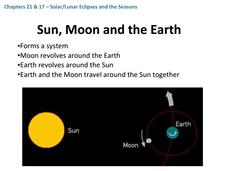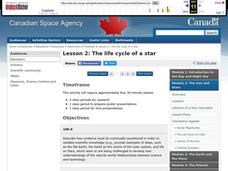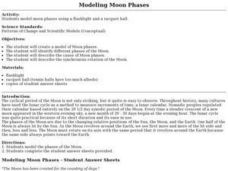Curated OER
Moon Exploration
Third graders investigate the phases of the moon. Using handheld computers, they describe the four phases of the waxing and waning moon, record their moon observations for a one month time period, create an illustration using Sketchy,...
Curated OER
Appearance of The Moon
In this moon worksheet, students are given the names of the eight phases of the moon and eight blank diagrams of the moon. They are to draw each phase on the diagrams.
Curated OER
Phases of the Moon Calendar
In this moon worksheet, students complete a moon calendar by filling in the different phases of the moon for every day of the month.
Curated OER
Phases of the Moon
For this phases of the moon worksheet, students first fill in and label a graphic organizer showing the moon's phases, then complete 5 fill in the blank sentences.
Curated OER
Moon Phases, Day/Night
Fifth graders observe a demonstration that shows how the alignment of the sun, moon, earth relate to the phases of the moon that occur each month. They describe the moon's phases after experimenting in a small group setting and recording...
Curated OER
How Does the Moon Seem to Change?
In this moon worksheet, students will discover why the moon seems to change in appearance over a month time period. Students will fill in the blanks of 5 statements in this graphic organizer.
Curated OER
Phases of the moon
In this phases of the moon instructional activity, students record in a record sheet the moon's phases over a period of several weeks. Students then answer one question.
Curated OER
Thirteen Moons on Turtle's Back
Students listen to the story of how the turtle's back relates to the Thirteen Moon Cycles of the Oneida. They draw a turtle's back and demonstrate how it can be used to convey the Thirteen Moon Cycle.
Curated OER
The Life Cycle of a Butterfly
Young scholars complete lessons on a butterfly life cycle, moon phases, hot water, and shadows. In this science lesson plan, students complete activities where they read books, look at demonstrations, and complete experiments.
Mr. E. Science
The Earth in Space
Do you think Earth makes fun of other planets for having no life? The presentation covers the rotation and revolution of both the earth and our moon. It provides explanations for seasons, tides, and eclipses. Lesson is the 20th in a...
Curated OER
Birthday Moon
In this science worksheet, learners describe and draw what the moon looks like in four phases. Students also research about what the phase of the moon was like on the day and year they were born. Learners ask their classmates and...
Curated OER
Regents High School Examination: Physical Setting Earth Science 2008
Throughout this earth science exam, high-school geologists complete a series of multiple choice and short answer questions about the solar system, atmosphere, and earth system. This is an amazing test, as are all of the exams developed...
Curated OER
Solar/Lunar Eclipses and the Seasons
How do the moon, sun, and Earth line up to create eclipses? Why do the seasons change throughout a year? The answers to these questions are explained through this series of slides. This apt presentation outlines information using bullet...
University of Colorado
Phases of Charon
Pluto, although no longer considered a planet, has five moons. Pluto's moon, Charon, is the focus of a resource that describes how the moon is viewed from the surface of Pluto. Photos help individuals see how Charon would look at...
Curated OER
Clip the Face
Students discover the moon's phases and the rarity of eclipses. In this lunar lesson plan, students view a video titled Spin Around the Solar System: A Moon Dance, which demonstrates the key differences between a lunar and solar eclipse....
Curated OER
Exploring the Night Sky: Fall/Winter
Students explain how moon phases occur. They explain three ways that the night sky has been used through history. Students locate some of the constellations in the night sky. They discuss stories and myths surrounding stars.
Curated OER
The Moon
Students design and build an ideal lunar settlement. In this astronomy lesson plan, students identify the key features of the moon. They compare its environmental condition with the Earth's.
Curated OER
Moon Watch
Third graders read books about the moon and discuss its perceived changes as it moves across the sky. They observe the moon over the course of a month and chart their observations. They discuss their observations and conduct further...
Curated OER
Spinning into Space
Students, through hands-on activities, teacher demonstrations, pictures, and informational books, complete a unit on the Earth and its place in the Universe. They make mobiles of the Milky Way and watch demonstrations of lunar and solar...
Curated OER
The Life Cycle of a Star
Young scholars investigate the life cycle of a star and make conclusions based on evidence, research, and observation. In this lesson on space and scientific investigation, students describe the relationships between science and...
Curated OER
It's Just a Phase
Sixth graders are introduced to the correct terminology for the phases of the moon and arrange picture cards in the correct order. They use flashlights and Styrofoam balls to illustrate the phases of the moon. They write science journal...
Curated OER
Once in a Blue Moon
Third graders identify the phases of the moon. They use technology to access websites on the Internet dealing with the moon.
Curated OER
Modeling Moon Phases
Students identify the phases of the Moon and the synchronous rotation. In this hands on lesson plan students will create a model of the Moon.
Curated OER
Phases of the Moon
Students create a model of the phases of the Moon by giving students pictures of the phases of the Moon, a picture of the Earth, and a picture of the Sun. They then take a picture, and stand in correct place to make the phases of the...

























